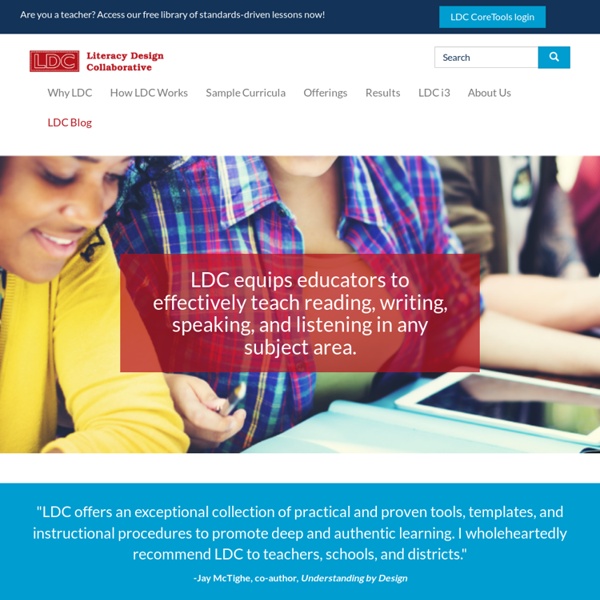



UDL-LDC Crosswalk The goal of this document is to provide an overview of how two educational frameworks, Literacy Design Collaborative (LDC) and Universal Design for Learning (UDL), complement each other in the design of curriculum in order to build pertinent literacy skills for all learners. At their core, both LDC and UDL have the goal of providing high quality curriculum to ensure learning is maximized for all students. To meet this goal, both frameworks recognize that it is essential to provide strong supports for educators in the design of robust instructional modules, units, and lessons. The LDC Framework emphasizes building college and career-ready literacy skills specified by the Common Core State Standards (CCSS). LDC focuses specifically on aligning lessons with the CCSS in order to build reading and writing fluency across content areas. Universal Design for Learning The UDL Guidelines focus on the design of lessons and instructional practices. LDC-UDL: Complementary Frameworks Resources
Kleinspiration Novel HyperDocs: 25 ready to use units for your class - Ditch That Textbook Novel HyperDocs are the brainchild of Heather Marshall when, after discovering HyperDocs (created byLisa Highfill, Kelly Hilton, and Sarah Landis), she decided to ditch the whole class novel and create interactive HyperDocs filled with paired texts, engaging media and interactive activities. Back in 2015, Heather shared her Novel HyperDoc for The One and Only Ivan which she created for her middle school English students. She shared this amazing resource for free through Twitter using the hashtag #TsGiveTs which promotes and supports teachers sharing resources with one another for free. Since then many others, including myself, have created and shared novel HyperDocs to use with grades ranging from 2-12. Like Heather's these units are completely free and filled with tons of resources to guide you and your students through a literary journey. The novel HyperDoc ripple effect. Using these novel HyperDocs with your class. These HyperDocs are listed in order of growing text complexity. 1. 2.
Free Technology for Teachers Kagan Catalog - Cooperative Learning Kagan Cooperative Learning Dr. Spencer Kagan & Miguel Kagan (All Grades) The book that started it all—is completely revised! Why would the Kagans update a classic that has sold nearly half a million copies? The answer: So much has changed! Cooperative Learning today is different. This new book presents today's most successful cooperative learning methods.
UDL-CCSS Video Crosswalk The National Center on UDL library of UDL principles and practice videos illustrate how to apply the UDL guidelines to classroom lessons. They can also be used to demonstrate how to address specific Common Core State Standards (CCSS). View the following videos and read these overviews to learn which UDL principles, UDL guidelines, and CCSS are highlighted in each video. The Grade 1 Mathematics video specifically addresses these Mathematics CCSS: CCSS.Math.Content.1.NBT.B.2: Understand that the two digits of a two-digit number represent amounts of tens and ones.CCSS.Math.Content.1.NBT.B.2a: Understand the following as special cases: 10 can be thought of as a bundle of ten ones—called a "ten." Grade 1 Mathematics The Grade 5 Language Arts (ELA) video specifically addresses these ELA CCSS: CCSS.ELA-Literacy.Reading:Literature.5.2: Demonstrate command of the conventions of standard English capitalization, punctuation, and spelling when writing.CCSS.ELA.Literacy. Grade 5 Language Arts
CDAT Teach online and make a living doing what you love | Teachable Which plan do you recommend? The most popular plan is our Professional plan. However, we also offer a free plan so you can try out Teachable and see if it’s a good fit for you. Can I offer free courses with Teachable? Absolutely! What happens if I want to cancel my plan? We'll be sad to see you go, but you can cancel your Teachable plan at any time. Do I need a web host? Nope. Is there a limit to how much content I can upload? Every Teachable plan includes unlimited video and course content bandwidth. Can I use my own domain name? On our Basic plan and above, you can use your own domain name (example.com). Do I need a payment processor? Teachable handles the payment processing for you, so you don’t need a separate processor. Do you charge a setup fee? With Teachable, there are absolutely no setup fees. What happens if I cannot set up direct payouts via Teachable Payments, Stripe Connect, or PayPal? How do transaction fees work? When do I get paid? Who pays my affiliates and authors out?
DOGO News - Kids news articles! Kids current events; plus kids news on science, sports, and more!